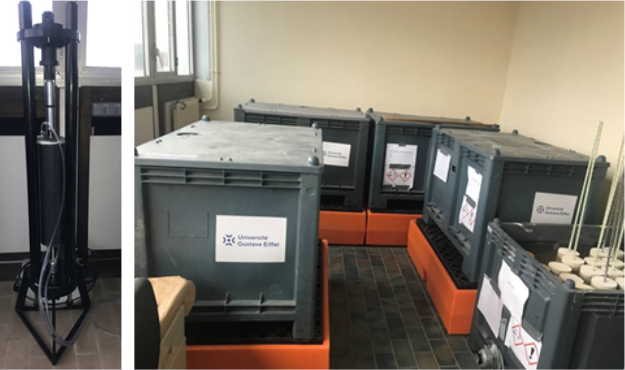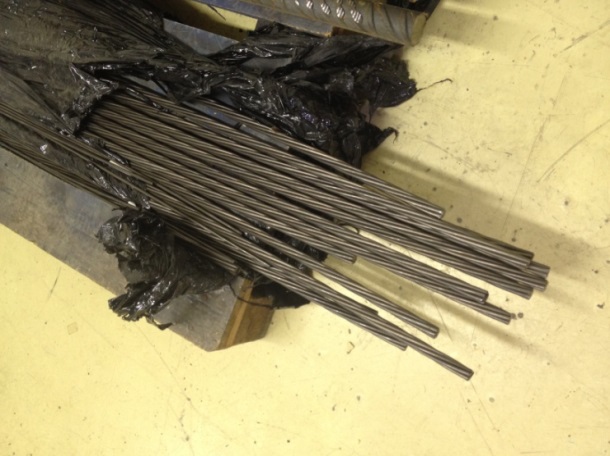Reinforcements and Cables in Civil Engineering
The SMC laboratory has unique expertise and experience at the national level regarding reinforcements and cables used in civil engineering structures. It has carried out numerous studies aimed at improving knowledge about the durability of reinforcements and cables, both for existing structures and for new construction solutions.

Durability of Composite Rebar
Fiber Reinforced Polymer(FRP) reinforcements are increasingly used in North America for the internal strengthening of concrete structures due to their excellent mechanical properties and corrosion resistance. In France, where they are currently not widely used, their potential is significant and working groups have recently been established to define a certification procedure and normative reference for these FRPs and to establish appropriate design rules for reinforced structures. However, the durability of FRPs - particularly under severe environmental conditions - remains a crucial research topic, despite numerous studies carried out by Canadian teams over the past fifteen years, and more recently by the Gustave Eiffel University, formerly IFSTTAR. The lack of data on the durability of PRF reinforcements, particularly in the context of aging under load (a combination of environmental aging in an alkaline medium and creep-type mechanical loading), still hinders their acceptance and widespread use. This research program aims at understanding and apprehending the damage mechanisms of composite reinforcements in an alkaline environment under load. It implements a wide campaign of accelerated aging under load (coupling between hygrothermal aging and creep) on FRP reinforcements based on glass fibers.
The thesis is carried out in collaboration with ANDRA, which plans to use this type of reinforcement in its storage structures. The SMC laboratory is involved in this project along with two other laboratories: the EMGCU laboratory of the MAST department and the Navier laboratory. CEREMA is also involved in the follow-up of the thesis work.

Experimental Study of Cement Grout-Injected Prestressed Cable Failure
Although the durability of prestressing is guaranteed in the vast majority of cases, several cable failures have been observed in large structures.
These failures are attributed to corrosion problems resulting from various initial causes.
The project aimed at simulating degradation resulting from corrosion by mechanically cutting wires to cause failures of strands and cables injected with cement grout.
Three tests were conducted on T15 strands and two tests were conducted on cables consisting of 5 T15 strands, following different cutting scenarios.
The main results show that wire anchoring by breakage mainly occurs through confinement in the PEHD sheath and that the damage mode is the same whether the failures were localized or generalized across multiple strands.
A failure rate of approximately 30% of wire breakages is sufficient to completely damage the strand or cable.
Our laboratory was involved in the mobilization of the 200m bench, assisting with test realization, non-destructive monitoring, and expertise of the tested cables.

MACENA project
The project funded by ANRT and called MACENA (MAîtrise du Confinement d’une ENceinte en Accident) focuses on modeling the evolution of porosity in a pre-stressed concrete structure as a function of temperature. This project is led by Grenoble-INP/3SR and is composed of the following consortium: CEA, CERIB, EDF R&D, IFSTTAR, LMDC, NECS, OXAND, and IPRA.
In this context, the SMC laboratory of Université Gustave Eiffel works on the issue raised by the metallic reinforcements of the structure (passive or active), relying on its expertise and extensive experience in these topics, and on its position as a major French actor in the certification of reinforcements and pre-stressing processes. More specifically, the laboratory is responsible for a state-of-the-art review of pre-stress losses evaluation on the type of structure studied (post-doctorate by Mélanie Denecker) and a relatively significant experimental study on the influence of temperature on the behavior of metallic reinforcements (post-doctorate by Wiem Toumi-Ajimi). The latter involves evaluating the evolution of tensile behavior of rebars and prestressing strands, the behavior of the interface between rebars and concrete, and the relaxation behavior of strands as a function of temperature.